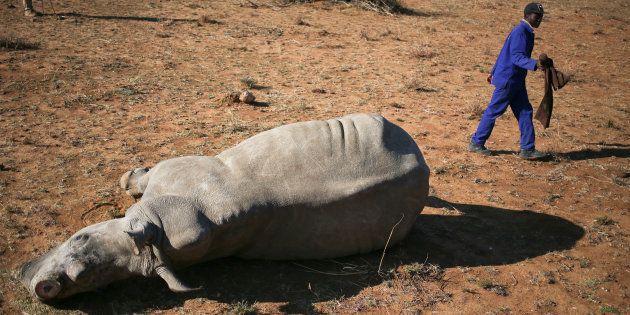
Rhinos are being poached by a myth, with 529 of the African giants having already been cut down in the first six months of the year. In the recently released independent film, "Hunted by a Myth", director Daniela Henao Cardenas tries to showcase how different points of view might lead to the survival of the species.
Cardenas explains how she wanted the title of her film to highlight that it's myths that are actually killing rhinos, as well as for it to be a thought-provoking introduction for the viewer. "The myth is basically that in China and Vietnam, the rhino horn can cure cancer or acts as some sort of aphrodisiac," she said.
In Asia alone, rhino horn is expected to fetch up to US$60,000 per kilogram, which has led to the suggestion that the trade of horn should be legalised as a possible solution to stemming the poaching crisis.
Cardenas goes on to explain how a single rhino horn is worth more than gold and cocaine on the black market, even though a horn is made up of little more than keratin, which can also be found in human fingernails.
The central point of the film revolves around a tear-jerking 24-hour period where game rangers find a poached rhino carcass and then find themselves in a race against time after realising it had a calf.
Cardenas explains that rhino calfs can only survive for so long after becoming separated from their mother. "They can die on their own because of a lack of milk or be killed by a predator." She adds that it was the first time she had seen a rhino carcass for herself and the harrowing moment brought her to tears.
I don't think by legalising it [rhino horn trade] will reduce trade but maybe if there's legal trade the money will go to the community involved.
In August the largest rhino breeder in the world, John Hume, was granted a permit for an online auction of 500kg of the six tons worth of rhino horn in his possession. Environmental Affairs Minister Edna Molewa granted Hume the permit on August 21, citing a Constitutional Court judgment in April that legalised the trade of rhino horn.
Cardenas interviewed Hume in her film and explained her decision to do so by saying that she wanted to give all sides of the debate a voice. "I respect every point of view. I don't think by legalising it will reduce trade, but maybe if there's legal trade the money will go to the community involved," said Cardenas, adding: "It's a really complex issue and people need to be open-minded."
That community consists of game rangers working on the reserves, as well the people who live around the area and the children who will become the future custodians of the rhinos.
The London-based Colombian film maker explains how she became motivated to do research into the rhino poaching crisis by speaking to fellow students while pursuing her master's degree at the MET Film School in London. "Some of my classmates came from Africa and specifically South Africa and all they spoke about was rhino poaching."
The plan moving forward is to make a sequel film with a focus on the Asian market and more emphasis on educational awareness. In the film, she highlights a key education campaign run by Dance to be Wild that facilitates dance programmes that look to educate children about rhino conservation through dancing.
The film is available for purchase and rent on Vimeo with 10 percent of the profits going towards the Dance to be Wild organisation.
